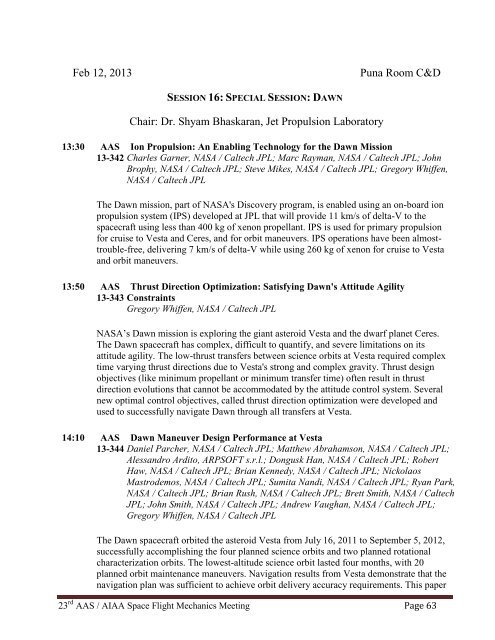meetings - Space Flight Mechanics Committee
meetings - Space Flight Mechanics Committee
meetings - Space Flight Mechanics Committee
Create successful ePaper yourself
Turn your PDF publications into a flip-book with our unique Google optimized e-Paper software.
Feb 12, 2013<br />
Puna Room C&D<br />
SESSION 16: SPECIAL SESSION: DAWN<br />
Chair: Dr. Shyam Bhaskaran, Jet Propulsion Laboratory<br />
13:30 AAS Ion Propulsion: An Enabling Technology for the Dawn Mission<br />
13-342 Charles Garner, NASA / Caltech JPL; Marc Rayman, NASA / Caltech JPL; John<br />
Brophy, NASA / Caltech JPL; Steve Mikes, NASA / Caltech JPL; Gregory Whiffen,<br />
NASA / Caltech JPL<br />
The Dawn mission, part of NASA's Discovery program, is enabled using an on-board ion<br />
propulsion system (IPS) developed at JPL that will provide 11 km/s of delta-V to the<br />
spacecraft using less than 400 kg of xenon propellant. IPS is used for primary propulsion<br />
for cruise to Vesta and Ceres, and for orbit maneuvers. IPS operations have been almosttrouble-free,<br />
delivering 7 km/s of delta-V while using 260 kg of xenon for cruise to Vesta<br />
and orbit maneuvers.<br />
13:50 AAS Thrust Direction Optimization: Satisfying Dawn's Attitude Agility<br />
13-343 Constraints<br />
Gregory Whiffen, NASA / Caltech JPL<br />
NASA’s Dawn mission is exploring the giant asteroid Vesta and the dwarf planet Ceres.<br />
The Dawn spacecraft has complex, difficult to quantify, and severe limitations on its<br />
attitude agility. The low-thrust transfers between science orbits at Vesta required complex<br />
time varying thrust directions due to Vesta's strong and complex gravity. Thrust design<br />
objectives (like minimum propellant or minimum transfer time) often result in thrust<br />
direction evolutions that cannot be accommodated by the attitude control system. Several<br />
new optimal control objectives, called thrust direction optimization were developed and<br />
used to successfully navigate Dawn through all transfers at Vesta.<br />
14:10 AAS Dawn Maneuver Design Performance at Vesta<br />
13-344 Daniel Parcher, NASA / Caltech JPL; Matthew Abrahamson, NASA / Caltech JPL;<br />
Alessandro Ardito, ARPSOFT s.r.l.; Dongusk Han, NASA / Caltech JPL; Robert<br />
Haw, NASA / Caltech JPL; Brian Kennedy, NASA / Caltech JPL; Nickolaos<br />
Mastrodemos, NASA / Caltech JPL; Sumita Nandi, NASA / Caltech JPL; Ryan Park,<br />
NASA / Caltech JPL; Brian Rush, NASA / Caltech JPL; Brett Smith, NASA / Caltech<br />
JPL; John Smith, NASA / Caltech JPL; Andrew Vaughan, NASA / Caltech JPL;<br />
Gregory Whiffen, NASA / Caltech JPL<br />
The Dawn spacecraft orbited the asteroid Vesta from July 16, 2011 to September 5, 2012,<br />
successfully accomplishing the four planned science orbits and two planned rotational<br />
characterization orbits. The lowest-altitude science orbit lasted four months, with 20<br />
planned orbit maintenance maneuvers. Navigation results from Vesta demonstrate that the<br />
navigation plan was sufficient to achieve orbit delivery accuracy requirements. This paper<br />
23 rd AAS / AIAA <strong>Space</strong> <strong>Flight</strong> <strong>Mechanics</strong> Meeting Page 63
















